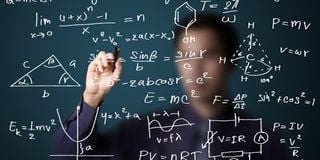Explainer: Think you don't use mathematics every day? Think again

Experts say we may not realise it, but we 'play with maths' almost every day, and some of the things we do routinely actually use maths.
Happy Pi Day or, if you love mathematics, happy 3.14 day!
Today is the International Day of Mathematics, which is celebrated on March 14 (3/14) and is called Pi Day because of the mathematical constant π (pi), which can be rounded down to 3.14.
The theme for the day is "Playing with Maths" and the aim is to celebrate mathematical games, puzzles and other fun activities, but also to "play" with mathematics itself, exploring, experimenting and discovering.
We may not realise it, but we 'play with maths' almost every day, and some of the things we do routinely actually use maths.
We spoke to Geoffrey Oduor, a statistician, who explained how some of the things we do in our daily lives require mathematics, despite popular belief to the contrary.
- Adjusting the volume on your TV set
When you pick up your TV remote to increase or decrease the volume, trigonometry is used based on the shape of the button you press on the remote and the shape you see on your TV screen.
- Using Wi-Fi
Many people have Wi-Fi installed in their homes, but not many of us think about the maths behind getting the signal from the router to your phone.
The best place to put your router is also based on mathematics and mathematicians have even come up with a formula that can work out the best place to put your router to get the best signal.
- Calculating burnt calories
When you go for a run and check your watch, you can see how many calories you have burned, your heart rate and more.
All this is calculated using mathematics and given to you in a matter of seconds. You don't really think about the mathematics behind it when you use these gadgets.
- Using your maps for navigation
When you get lost and take out your phone to open a navigation app, geometry comes into play. GPS navigation uses satellites, which can only work out your location by calculating the distance from one point to another.
- Using an ATM
When you go to an Automated Teller Machine (ATM) to make a transaction, the machine uses mathematics to dispense your notes and calculate your balance.
The programming of the machine is based on mathematical calculations because the machine is not operated by a human.
Knowing maths better
According to Mr Oduor, there are two branches of mathematics: Pure and Applied Mathematics.
Pure mathematics is the branch that is more about the study than the application of mathematics in real-life situations.
It is mainly concerned with abstract concepts, developing theories and trying to solve mathematical problems.
Geometry, algebra and number theory are some of the branches of pure mathematics.
Those who study pure mathematics can work as mathematical researchers.
Applied mathematics, on the other hand, is used to solve practical problems.
The use of mathematical methods in finance, accounting, engineering and computer science is applied mathematics. Those who study applied mathematics work in these fields.
Calculus, statistics and probability, and basic arithmetic are all branches of applied mathematics.





